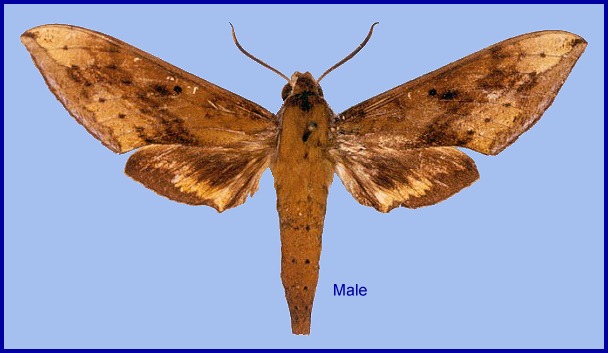
Rhagastis jordani Oberthür, 1904, Bull. Soc. ent. Fr. 1904: 14. Type locality: China, Siao-lou [Sichuan, Xiaolou].
Synonym. Rhagastis jordani Oberthür, 1904.
Male very similar to Rhagastis chinensis Mell, 1922, but the size is larger and the colour tends to be more yellow. Forewing much wider and longer; outer margin more curved; oval patch across the postmedian lines and near the apex and black zigzag lines on the forewing upper side more obvious than in R. chinensis; the blackish zigzag medial line on forewing underside are much thicker. The female is similar to the male, but the wings are broader and the ground colour is paler; patterns of the forewing and hindwing more faded than in the male (Jiang et al., 2024).
Male genitalia are similar to that of R. chinensis. Sacculus much shorter and apex bent upward apically like a spike. The phallus is longer and straighter, the anterior lobe of the process is slender, and one of the sides has sparse apical spines (Jiang et al., 2024).

Unknown.
China: iv (Guizhou); vi (Guangxi; Chongqing); vii (Hubei).
OVUM: Unknown.
LARVA: Unknown.
PUPA: Unknown.
Larval hostplants.
Unknown.
Unknown.
China: Hubei (Baokang, Xiangyang, 1500m; Enshi); Chongqing (Yintiaoling, Wuxi, 1130m); Guizhou (Libo; Maolan, 975m); northern Guangdong; Guangxi (Maoer Shan, 1800m).
South-central China.

Map: Distribution of species of the olivacea group of the genus Rhagastis. The green dotted line indicates the range of R. confusa, the red dotted line indicates the range of R. olivacea, the blue patch indicates the range of R. jordani, the orange patch indicates the range of R. lunata, and purple triangles indicate the range of R. gloriosa. (© Jiang, Wang, Xu, Kitching, Huang, Hu & Xiao, 2024).
 Return to Sphingidae of the Eastern Palaearctic species list
Return to Sphingidae of the Eastern Palaearctic species list